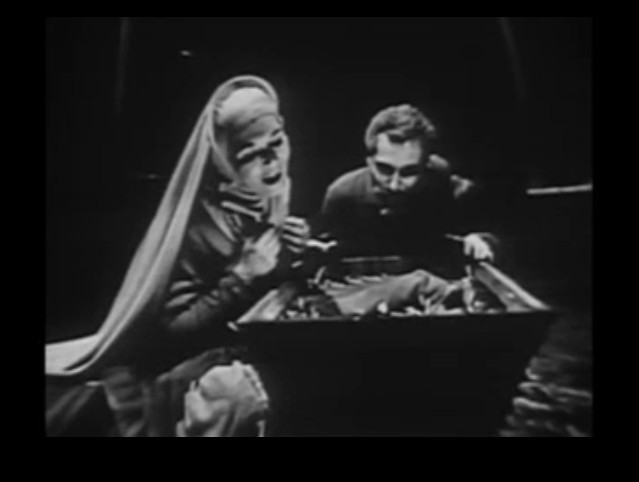
For kids in the 1960s and 1970s, the Christmas season didn’t really begin until a new round of holiday television specials made their appearance. With TV viewership dominated by three major networks, programs such as “Rudolph the Red-Nosed Reindeer” (1964) and “How the Grinch Stole Christmas” (1966) became family traditions across the country.
Many of these programs were created by the prolific New York company Rankin/Bass Productions. The team of Arthur Rankin, Jr. and Jules Bass became famous for their quirky stop-action puppet animation (actually filmed in Japan) in holiday classics such as “Rudolph” and “Santa Claus is Comin’ to Town” (1970) as well as traditional animated cartoons such as “Frosty the Snowman” (1969).
December 2018 marks the anniversary of two Rankin/Bass products that are less seen today. “The Little Drummer Boy” debuted 50 years ago in 1968, a religious tale of an orphan whose dying lamb is saved when the lad plays his drum for the newborn baby Jesus. And a rarely aired cartoon from 1978, “The Stingiest Man in Town,” marks its 40th anniversary.
In theme and content, both shows connected to the earliest years of the TV holiday special, a history that involved multiple Pittsburgh companies.

Television takes over
Perhaps no invention overtook American households as quickly as television. While early experimental models existed by the 1930s, the television as we know it emerged after World War II. By the mid-1940s, a few thousand lucky homes had the new picture box. Pittsburgh’s first broadcast TV station, WDTV, started airing in 1949. By 1951, the number of household televisions had soared to around 12 million.
As television ownership expanded, so did broadcast offerings. Programming often followed radio’s model of a live show sponsored by a major corporate partner. U.S. Steel, Alcoa, and Westinghouse all put their names on television anthology shows. Westinghouse, which manufactured televisions, went further and purchased WDTV, transforming it into KDKA-TV in 1955.
Celebrate the season on the small screen
Broadcasters quickly realized the benefits of holiday programming. Early shows featured one of two sources: stories about the nativity itself, or classic dramatic works staged for television. One of the earliest Christmas TV specials, now lost, was a 1950 showing of Victor Herbert’s Christmas musical “Babes in Toyland,” an operetta he composed in 1903 while he was serving as conductor of the Pittsburgh Symphony. In 1952, Westinghouse’s Studio One anthology on CBS broadcast “The Nativity,” a rare performance based on original 14th and 15th century English mystery plays, complete with old English words and an Elizabethan dialect. (See an archived version.) Not surprisingly, Charles Dickens’ “A Christmas Carol” was also popular, as were English dramas in general throughout the programming year.
Not all Pittsburghers approved. One disgruntled Studio One viewer wrote to the Pittsburgh Press in November 1952 complaining about the “Johnny Bull namby-pamby shows” chosen by Westinghouse. He wanted “American-acting, American-speaking plays” with more “zip” than those “panty-waist English plays.”[i] The Christmas airing of “The Nativity” probably didn’t please him.
Dickens remains a favorite
Notwithstanding a few disgruntled viewers, TV anthologies continued to repeat holiday stories on an annual basis. In 1956, the Alcoa Hour on NBC offered a new take on “A Christmas Carol.” Entitled “The Stingiest Man in Town,” the 90-minute musical drama featured Basil Rathbone as Scrooge and included popular singers such as Vic Damone, Johnny Desmond, and The Four Lads. (Watch an excerpt.) Pennsylvania TV critics liked the special, although the Philadelphia Inquirer found some sequences a bit “ghoulish” for young viewers.[ii] New York critics were less enthusiastic. Despite the urging of the Post-Gazette’s television and radio writer Win Fanning that Alcoa not let “adverse criticism by . . . New York’s TV writers scare them,” the show never aired again.[iii] It did result in the release of soundtrack LP that became more popular than the original show. (The broadcast was considered lost until a black and white kinescope copy was discovered and released on DVD in 2011.)
Enter Rankin/Bass Productions
Alcoa never rebroadcast the original show, but the company retained an interest, and eventually licensed the broadcast rights to the music and lyrics. In 1977, Alcoa negotiated a new TV production with Rankin/Bass. Scrooge would be played by Walter Matthau. This time, the special was animated, because, the Alcoa public relations department said, “we were advised that an animated show gets the best audience.”[iv] Alas, the special aired on NBC the same night as the 1978 Tangerine Bowl featuring Pitt versus North Carolina, a factor that probably got it preempted in many Pittsburgh households.
The new version never became a Rankin/Bass holiday standard, but it did give another local Alcoa group a chance to shine. In conjunction with the TV program, the Alcoa Singers, a musical group made up of Alcoa employees who performed for their fellow Alcoans at company functions and in concerts throughout Pittsburgh, recorded an LP featuring music from the “The Stingiest Man in Town.” (Listen to excerpts.)
A copy of that album, “An Old-Fashioned Christmas,” is now preserved in the History Center’s Detre Library & Archives. It’s a reminder of the many industrial choruses that were once part of Pittsburgh’s cultural landscape (U.S. Steel and Westinghouse also had them), and an offbeat artifact of Pittsburgh’s corporate connections to the celebration of the holiday season on the small screen.

Do you remember seeing any of these TV specials? Were you part of the Alcoa Singers?
Feel free to post and share your story!
[i] The Pittsburgh Press, November 6, 1952
[ii] “’Stingiest Man’ Joins Classics,” The Philadelphia Inquirer, December 24, 1956
[iii] “A Musical ‘Carol’; Other Notes,” Pittsburgh Post-Gazette, December 28, 1956.
[iv] Barbara Holsopple, “Pittsburghers Revive Scrooge One More, Happy Time,” Pittsburgh Press, December 20, 1978.
Leslie Przybylek is senior curator at the Heinz History Center.






